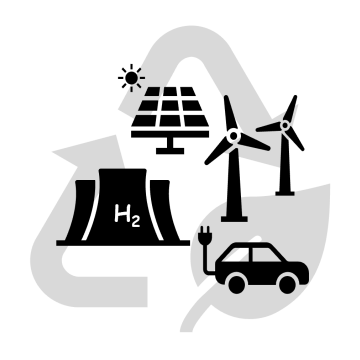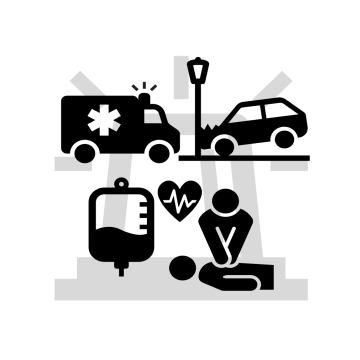BORDERLESS TRAFFIC SAFETY RESEARCH
Dedicated to saving lives, preventing injuries, and promoting safe mobility
Every year, approximately 1.2 million people lose their lives in traffic accidents, with countless more suffering injuries. Tragically, road transport injuries are the leading cause of death for children and young adults aged 5-29 years. Without significant changes, this figure could rise even more. This underscores the urgent need for collaboration through the SAFER platform.
SAFER's research agenda is shaped by its partners' interests and society’s needs, contributing to a larger societal goal: the development of smart, sustainable road transport systems in urban and rural areas alike. Employing an interdisciplinary approach, SAFER aims to establish the scientific foundation for safe products, services, infrastructure, policies, and legislation.
SAFER conducts research across three Impact Areas: Human Body and Mind, Safety Performance Evaluation, and Safety Principles.
SAFER'S IMPACT AREAS
The scope of our research
We define our impact areas by assessing both societal and our partners’ needs, focusing on where SAFER, as a collaboration platform, can truly make a difference. This is guided by a comprehensive understanding of our combined capabilities and the demands of society.
SAFETY PRINCIPLES
SAFETY PRINCIPLES
The Impact Area Safety Principles focuses on addressing safety for individual components such as vehicles and infrastructure, as well as the interactions between them to capture the challenges of the whole mobility system. Our primary objective is to reduce fatalities and injuries, by preventing road accidents in the first place. Our Impact Area Experts in the SAFER Research Council: Martin Sanfridson, RISE and Katrin Sjöberg, Volvo Group.
HUMAN BODY AND MIND
HUMAN BODY AND MIND
Here we address our understanding of the human from the aspects of tolerance to mechanical loading and behaviour in traffic. The research activities typically focus on modelling of the human and studying the safety of interactions between road users and between the human and the vehicle in the mobility system. Our Impact Area Experts in the SAFER Research Council: Nils Lübbe, Autoliv, Anna Sjörs Dahlman, VTI and Mikael Ljung Aust, Volvo Cars.
SAFETY PERFORMANCE EVALUATION
SAFETY PERFORMANCE EVALUATION
In the impact area Safety Performance Evaluation, our research is dedicated to advancing vehicle and traffic safety through innovative analysis techniques. Our mission is clear: to develop models that are transparent, scalable, and sustainable, all grounded in real-world data and assessment methods. Our Impact Area Experts in the SAFER Research Council: Jonas Bärgman, Chalmers, Carmelo D'Agostino, Lund University and Hanna Wennberg, Swedish Transport Administration.
SAFER’S WORKING GROUPS
The main forum for inspiration and idea incubation
PARTNER PROJECTS
Real-world traffic safety research to save lives
SAFER’s partners conduct world-class traffic safety research in a multidisciplinary, collaborative approach. Since our start in 2006, our partners have completed more than 450 traffic safety research projects with the aim of saving lives, preventing injuries and contributing to sustainable, safe mobility.
THE SAFER CONNECTED RESEARCH RESOURCES
As a SAFER partner, you gain through projects, access, to SAFER’s Connected Research Resources available within the network. Expertise for utilizing these resources is readily accessible within the community. Our overarching goal, and a strategic cornerstone, is to make research easier, more effective, and efficient through collaborative partnerships. Together, these resources allow borderless research with outstanding opportunities of real-world testing and validation.
ASTAZERO REAL-WORLD TEST FACILITY
AstaZero (Active Safety Test Area Zero) is among the world's most advanced full-scale test environments, dedicated to fostering a safe, sustainable, and connected automated road traffic future. With diverse traffic environments, it facilitates testing of advanced safety systems across various traffic scenarios, including urban, rural, multi-lane, and high-speed roads. Additionally, boasting the world's longest indoor autonomous vehicle test track, AstaZero enables extensive research, development, and validation. Serving as an international testing area, it welcomes stakeholders from industry, society, and academia.
Read more at www.astazero.comREVERE RESEARCH LAB FOR ACTIVE SAFETY AND AUTONOMOUS DRIVING
Chalmers' Revere lab, closely connected to SAFER at Lindholmen Science Park, is an evolving comprehensive research platform. It provides partners with facilities for real-world traffic and simulator studies, focusing on autonomous driving, active safety, and vehicle dynamics. Equipped with technical tools, test vehicles and dedicated personnel, Revere facilitates collaboration between industry stakeholders and academia, driving cutting-edge research and innovations.
Read more at www.chalmers.seTHE SAFER NATURALISTIC DRIVING DATA PLATFORM
SAFER's Naturalistic Driving Data platform securely manages vast real-world driving datasets, spanning approximately 6.5 million kilometers. It offers state-of-the-art data management, large datasets, and leading research expertise. This platform provides unique access to naturalistic data, supporting streamlined traffic safety research and fostering collaboration.
Do you want to know more, please contact John-Fredrik GrönvallTHE SAFER DATA CATALOGUE
Knowledge of different datasets available in SAFER's network is important for efficient work within projects, providing new perspectives on past and present research, and being able to create completely new projects through data-driven research. To facilitate access to quality assured data, the SAFER Data Catalogue, where relevant datasets within the network are described, are available for the SAFER partners. The datasets cover different types of data, from field operational tests with a vehicle or location-based focus, real-time data described in the Swedish National Access Point (NAP), and accident databases.
SAFER Data CatalogueDRIVING SIMULATORS
The Sim IV driving simulator at VTI, equipped with its advanced motion platform system, is instrumental in our research endeavors across various projects. This simulator offers substantial linear movement on both x and y axes, prioritizing motion feedback and providing a wide field of view. It gives us the possibility to conduct simulations for cars, trucks, and bicycles. Additionally, the mini simulator at Lindholmen gives us the opportunity to significantly enhance our research capabilities.
Read more at www.vti.seVENUE AT LINDHOLMEN SCIENCE PARK
SAFER operates from Lindholmen Science Park, Sweden's epicenter for future mobility innovation and cross-border cooperation. With 25,000 daily visitors, Lindholmen fosters a collaborative ecosystem. Our partners have access to a 290 sqm facility offering workspaces, meeting rooms, analysis facilities for confidential driving data, and venues for co-creation, conferences, and networking. This dynamic environment facilitates interdisciplinary collaboration, advancing research in traffic safety.
Read more at www.lindholmen.seWORLD LEADING HUMAN BODY MODEL FUNCTIONALITY
Within human body modelling (HBM), SAFER provides a competence platform for our partners as well as a natural contact point for external cooperation. The SAFER HBM is a virtual human substitute that can be used for predicting injury outcome in any impact situation and direction of loading, able to be morphed to replicate a large proportion of the population, standing or sitting, with humanlike kinematics in crash events as well as pre-crash maneuvers. The SAFER HBM research combines several projects, all developing the existing model towards the overall goal of performance.
TEST TRACK AT STORA HOLM
SAFER's partner, the road safety organisation NTF Väst, provides our researchers access to a conveniently located traffic training site at Stora Holm, near Lindholmen. This versatile facility offers various driving surfaces, including gravel, asphalt, and slippery terrain, set amidst hilly landscapes. The off-road course, nestled in a natural setting, enables additional practice on transverse slopes and features a water-filled ditch. Besides serving as a training ground, Stora Holm test track is an ideal venue for outdoor events and demonstrations, enriching research activities.
Read more at storaholm.se
RESEARCH PROGRAMMES
Our funding opportunities for partners
SAFER offers its researchers access to research programmes with funding opportunities.
SAFER IDEA EXPLORATION PROGRAMME
Do you have an idea on how traffic safety can be improved? We have an opportunity to support you through our Idea Exploration program! To support the development of the project portfolio, the SAFER idea exploration program is an important part of how we facilitate and influence research. In this program, we fund research activities that can bring value back to SAFER’s partners, supporting our vision to contribute to a safe road transport system for all.
Welcome with your application!OPEN RESEARCH AT ASTAZERO
This programme (open 2016-2021) funded curiosity projects by providing free access to AstaZero to stimulate and facilitate open, independent and world-leading research. The programme aimed to generate openly available results and data and an inspiring network between researchers. Researchers from universities or research institutions as well as small and medium-sized enterprises (SMEs) could apply for test track time, workshop use, support (e.g. testing engineers, or drivers), and use of equipment.
SAFER DOCTORS
Connecting minds in our PhD network
All our SAFER doctors will be listed here shortly.











